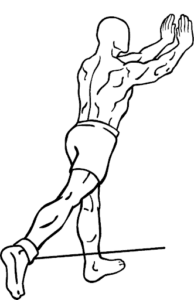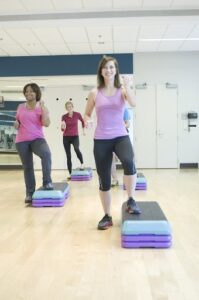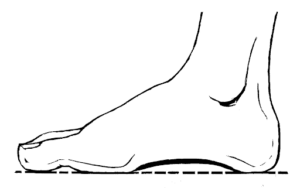Running is a natural form of movement that involves segments of the entire body. This includes the arms, upper spine, lower spine, pelvis, lower legs, ankles, feet and even the toes! Each segment plays an important role in the form of running. If there is a deficit in one area, it trickles up or down the chain and can affect other parts of the body. We are one unit that works most efficiently when everything is in synchronization.
Mechanically, running involves a stance, swing and float phase. What does this mean exactly? Well first, a stance phase means that one leg is in contact with the ground. On the contrary, the opposing leg is in the swing phase, meaning that the leg is in the air getting ready to make contact with the ground. We are constantly switching from swing to stance while we are running. So what about the float phase?
The float phase only pertains to running; we do not have a float phase in walking. For a very short period of time as one leg is switching from one to another, there is a fraction of a second when both legs are in the air. This means that one leg is in the swing phase and one leg is preparing for landing, which is called initial contact. What happens during the trade off between swing and stance phase is what we pay most attention to when evaluating running mechanics.
The amount of informational running tips out within the communities, both medical and recreational, can be overwhelming. What should you listen to? There are several trained professionals (personal trainers, running coaches, Doctors of Physical Therapy) who understand the form of running and know what to look out for regarding energy leaks and muscle weakness that could lead to pain and running discrepancies over time. I would suggest going to a professional that you trust because they have the best interest for you. However, it is also equally important to go to a professional who has specific experience working with runners!
As a Doctor of Physical Therapy (DPT) I like to educate that there is no universal form for optimal running. Each and every person runs differently and that is ok! One person should not replicate another person’s running. As a body analyst and educator my job is to analyze each individual’s run and advise based on those findings. The goal is to optimize his or her form which reduces the likelihood of injury and allows for a more efficient run.
A Doctor of Physical Therapy is clinically trained to understand overall body mechanics in any functional form so we can specifically educate and provide individualized treatments to each person. If you wish to have your running evaluated by a DPT, we will not only evaluate your running mechanics, but we can treat and advise you with specific movements to enhance your body so you can become a stronger and more efficient runner. Who wouldn’t want that? To have an individualized and personalized plan, please consult with your local Doctor of Physical Therapy.
With all above considered, it is recommended for the average runner to be professionally evaluated! On average, runners demonstrate common weaknesses and energy leaks that impact his or her run. Overall, research has shown that certain recommendations have helped minimize these weaknesses and have enhanced the runner’s performance while reducing the risk of injury.
Running involves the following:
- Arm Swing/Trunk rotation
- Hip Drop/Knee position
- Hip Extension
- Rate/Amount of Pronation
- Heel Contact
Since some of these components can turn into weaknesses and energy leaks, below is the breakdown of how that can happen. Furthermore, there are specific recommendations for each weakness that helps to improve the runner.
Arm Swing/Trunk rotation
A common weakness that runners experience is a condition we call “sleepy” glutes. For a multitude of reasons our glutes may have issues with activating at the most appropriate times, the times we need them the most. Our gluteus maximus is a big power house, it helps extend the hip. If we have tightness in the front of our hips (maybe due to over sitting) the glutes do not have an advantage to activate thus we may have limited hip extension and therefore our glutes are sleepy!
Our body is smart and it will learn to compensate for its loss. If we are not using our back or posterior muscles, we will begin to pull through our run rather than push through it with our glute muscles. We will overly rotate from our upper trunk and arms to get our leg to fling forward so it can go backward as we run. To help minimize these weaknesses, a glute activation cue with a hip flexed position is a great way to stimulate correct timing of the glutes during the run! Try this standing glute activation exercise below.

Start at the wall in a slightly bent over position so you have some flexion in the hips. You can use a band around both ankles or use an attachable weight as shown. Before moving your weighted leg back into extension, think about squeezing the glute muscles. The more you think about squeezing the muscle, the more it will activate over time! You can repeat a rep scheme for three sets of 10.
Hip drop/Knee Position
Ideally the knees should stay within midline (in the middle) while running. Many factors can reduce this form, which includes weakness at the hips or even the ankle. When the hip drops greater than 10-15 degrees the force can trickle down to the knee and influence the knee to cave inward. Over time, this could place stress on the knee, typically the inside part of the knee. Additionally, the force can radiate all the way down to the ankle and can influence the over pronation we will soon talk about! To correct or to control this deficit, we need to work on strength and control of the hips and ankle in order to build stability at the knee. This will in turn conserve our energy within our run and optimize our overall performance. Once we have control of the pelvis and lower body we can become more efficient in our mechanics and performance. An exercise that is great to strengthen the entire lower body is a lateral step down.

Find an elevated surface or a step and place your foot on the most outer edge of the step. Before starting the exercise, make sure you are standing completely upright on the step (step up on the step). The movement includes your free foot coming down to the ground as shown in the picture. When you have reached the ground squeeze your thigh and butt muscles and step back up onto the step. You can repeat a rep scheme of three sets of 10.
Hip extension
Optimal measure of hip extension should be about 10-15 during terminal stance, the last state of stance. When there is a loss of hip extension the body will compensate in order to achieve this movement. We need our extension in order to move!
Do you have back or hip flexor pain? Do you suffer from hamstring or calf tendonitis? Well, you may need to increase hip extension! If we are unable to optimally move our hip back into extension, we will begin to compensate from our back (lumbar spine) to achieve this motion. This may be because our hip flexors are tight which prevents extension but this is not the only reason why hip extension can be limited. Thus it is important to get evaluated! Regardless when we have this limitation, other parts of the body like our back, hamstrings and calves can be overused, which overtime could lead to pain and injury.
A good stretch that helps decrease this compensation is the Thomas Stretch. This is a great hip flexor stretch! If we gain mobility of the hip flexors then our motion to bring the hip back into extension could increase, thus, our compensation decreases and we can optimally use our gluteus maximus muscles. In addition, a real time running cue that can be helpful to reduce this compensation is the forward trunk lean. If we try to fall forward just slightly from our ankles we are retraining our bodies to angle forward which can change the force application and enhance the activity of glutes. If we can use our glutes more, we can achieve more hip extension

The hip you wish to stretch will be the knee that is kneeling on the floor. Make sure your pelvis is tucked underneath of you, which will optimize the stretch of the hip flexor stretch. Slightly lean forward to bring the hip into hip extension and hold for about 30 seconds.
Rate/Amount of Pronation
Our foot and ankle move in a triplanar motion, meaning it moves in three motions that pair together. The one motion that is often overdone is called pronation. This is when the arch of the foot flattens or falls to the floor. For some people, the timing of pronation may happen too fast and for others the amount is too much. A great way to ease this weakness is to strengthen the foot! Try foot doming.
Furthermore, you want to work on mobility of the foot and ankle joints in the event these joints are tight. When you create more motion and strengthen at the same time you are creating new range and new strength so you have better control of your foot that can improve the rate and amount of motion!

Begin in a staggered standing position with your front knee slightly bent and your back knee straight.Try to lift up the arch of your foot while keeping your toes and heel in contact with the ground. Make sure to avoid gripping with your toes. A slight weight shift to the outside of your foot is normal.
Heel Contact
You may be familiar with the different types of landing. The three different types include heel, midfoot and forefoot striking. The most ideal landing is the midfoot and forefoot; these mechanisms of landing influence a smaller stride which allows more knee flexion when the foot hits the ground.
When you have a smaller stride, landing closer to your center of mass (COM), and greater knee flexion angle during contact there is less stress from the ground force into your joints. These components allow the force to spread more to your muscles which support your body and joints. Your muscles act as the shock absorber rather than your joints, which can reduce the likelihood of stress fractures, shin splints and overuse injuries like tendonitis.
The best remedy to ease this running discrepancy is a real time running cue of manipulating your cadence. If you increase the steps you take per minute by 10% you will take closer steps to your COM which will encourage more knee bend and midfoot landing. This will allow the forces to be absorbed by muscles and reduce the lower body pains you may be experiencing!
To calculate your cadence you would count the amount of steps you take while running in one minute and then multiply by two since you have two feet! Once you have that number you then would take 10% of it and then try to perform that amount of steps in those next minutes that you run. Today’s world is digital so if you use a tracker while running, they usually track your cadence, which makes this process easier. You would find the cadence calculated on your tracker and again multiply by 10% and use that number in the next run!
Overall, what can you do to help your running efficiency and performance? Strengthen with intention! Gain control where you have noticeable weakness and make sure you create more mobility within areas that you feel restricted! It is also important to warm up pre run with dynamic stretches. Dynamic means active movement, so you want to stretch with movement! This form of stretching alleviates energy loss within muscles; static stretching is the corporate of energy loss so it is not advisable to perform this stretching before any type of running!
Furthermore, it is also important to cool down! Running as you just learned is multifactorial and involves the ENTIRE body. Thus, it is important to lower the heart rate and relax those muscles you just worked so hard! During this time of a cool down it is now advisable to perform static stretches since you just used all of your energy during the run. All of these running components work together to perform the movement of running. The goal is to synchronize and optimize our movements so we can live long and move in a healthy way!
